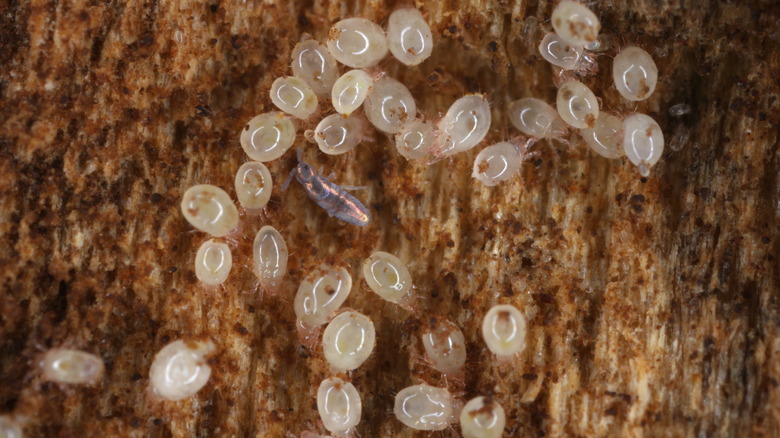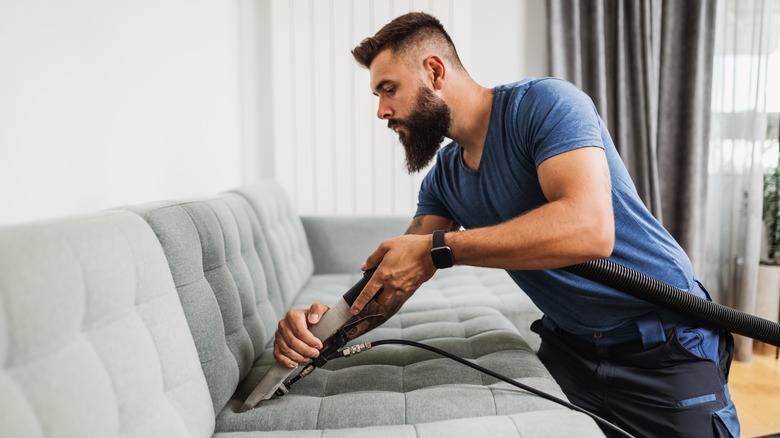This Type Of Furniture May Be Secretly Attracting Dust Mites To Your Living Space
Dust mites are microscopic creatures that thrive in the many nooks and crannies of our living spaces, making them a pervasive household problem. Being invisible to the naked eye makes these allergen-triggering pests hard to detect even as they cause respiratory problems and allergic reactions for many. While commonly found in bedding and carpets, an often-overlooked haven for dust mites is upholstered furniture. Your cozy couch may be harboring more than comfort; it could be a hotspot for these unwelcome intruders. This is why cleaning upholstered furniture properly is paramount.
Dust mites pose various health risks, particularly for individuals with allergies or respiratory conditions, and children whose immune systems are still developing. Dust mites produce proteins found in their droppings and body fragments, which can trigger allergic reactions. Common symptoms include sneezing, runny or stuffy nose, itchy or watery eyes, and skin rashes. These reactions can be particularly problematic for individuals with asthma, exacerbating symptoms and potentially leading to more frequent and severe asthma attacks. Dust mite allergens can inflame the airways, leading to coughing, wheezing, and difficulty breathing. They may contribute to the exacerbation of eczema symptoms in individuals prone to this skin condition.
While dust mites primarily affect humans, pets can also experience health issues related to indoor allergens. Pets can carry dust mite allergens on their fur, potentially causing skin irritation and discomfort. Additionally, pets with allergies themselves may experience worsened symptoms in environments where dust mites are prevalent.
Why upholstered furniture attracts dust mites
Upholstered furniture includes plush cushions with soft, porous textures and other fabric-covered surfaces that create an ideal environment for dust mites to settle. The fibers in the fabric trap and retain not only skin flakes but also moisture, creating a humid microclimate –- perfect for dust mite proliferation. The warmth generated by our bodies while lounging on sofas and other fabric furniture further enhances this cozy environment. Moreover, the intricate stitching and seams in upholstery offer numerous hiding spots for dust mites to flourish undisturbed.
Dust mites feed on dead skin cells, which we naturally shed daily. Additionally, upholstered pieces tend to accumulate an array of substances, including pet dander, pollen, and other airborne particles. In this dusty haven, dust mites thrive, making it crucial to understand why upholstered furniture is such a magnet for these microscopic pests.
To combat a dust mite infestation in your upholstered furniture, consider implementing thorough cleaning routines. Regular vacuuming using a machine equipped with a HEPA filter can help remove dust mites and their droppings, surface dirt, and allergens from carpets, upholstery, and curtains. Consider regular steam cleaning, which effectively kills dust mites and sanitizes upholstery. Encasing your furniture with allergen-proof covers adds an extra layer of protection.
Other tips to have a dust mite-free habitat
Making your home inhospitable to dust mites involves strategic planning. Opt for washable curtains and bedding to minimize potential mite havens. Keep humidity levels below 50% using a dehumidifier, as dry environments deter dust mite activity. Choose hard-surfaced flooring over carpets, and employ air purifiers equipped with HEPA filters to trap airborne particles, including dust mites. Dust surfaces regularly using a damp cloth or electrostatic duster to prevent the resettling of airborne particles. Focus on areas where dust tends to accumulate, such as shelves, picture frames, and electronics.
If your children have stuffed toys, consider placing them in a plastic bag and freezing them for a day or two. This can help kill dust mites without the use of chemicals. For homes with pets, groom your fur babies regularly to minimize the transfer of dust mites on their fur. Use pet-friendly wipes to give their fur a quick clean, especially after outdoor activities. Regularly washing bedding, including mattress covers, in hot water helps get rid of dust mites and their eggs. Invest in allergen-proof mattress and pillow covers to create a barrier against these microscopic pests. Remember, a proactive approach to cleanliness is key in making your home an unwelcome place for dust mites, so you can enjoy a healthier and more comfortable living environment.


